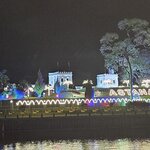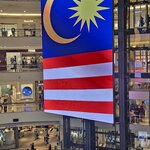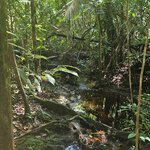Highlights
- Visit famous landmarks and museums in Kuala Lumpur
- Take a day trip to the jaw-dropping Batu Caves and meet monkeys
- Get close to nature while staying at campgrounds in a national park
- Hike to Clearwater Cave, Asia's longest cavern at 66 miles (106 km)
Brief Itinerary
| Day | Highlights | Overnight |
|---|---|---|
| Day 1 | Arrive in Kuala Lumpur, City Tour | Kuala Lumpur |
| Day 2 | Day Trip to the Batu Caves | Kuala Lumpur |
| Day 3 | Explore Kuala Lumpur's Museums & Oceanarium | Kuala Lumpur |
| Day 4 | Fly to Miri, Visit Tusan Beach | Miri |
| Day 5 | Transfer to Gunung Mulu National Park, Explore Deer Cave & Lang Cave | Mulu |
| Day 6 | Visit an Indigenous Village, Explore Caves, Hike to a Jungle Camp | Mulu |
| Day 7 | Hike to Mount Api & the Mulu Pinnacles | Mulu |
| Day 8 | Hike to Clearwater Cave | Mulu |
| Day 9 | Transfer to Miri, Optional Activities | Miri |
| Day 10 | Depart Miri |
Detailed Itinerary
Day 1: Arrival in Kuala Lumpur, City Tour

Welcome to Malaysia! Known for its rainforests, beaches, and islands, this country is as beautiful as any hotspot in Southeast Asia, yet it's not as exploited by tourism as some of its more famous neighbors. That means visitors are treated to an authenticity that makes for a truly unforgettable vacation.
You'll arrive in the nation's capital Kuala Lumpur. This city of around two million people is the perfect introduction to Malaysia's cultural, ethnic, and religious diversity. Residing in this melting pot are Muslims, Buddhists, Christians, Hindu Malays, Indians, Chinese, and many Indigenous groups and sub-groups. You'll see, hear, and taste these unique cultural influences in the country's music, art, and cuisine. At the airport, a driver will pick you up for the 45-minute ride to your hotel in the heart of the city.
Day 2: Day Trip to the Batu Caves

After breakfast, you'll hop in a car with your guide and visit some of the highlights just outside of Kuala Lumpur on a day trip. First up is Sky Mirror, a pretty beach that doubles as an optical illusion. At low tide, the wide sandbar here, which is normally submerged, shimmers with the residual water, creating a reflective effect. The mirror-like quality of the locale makes this one of the great photography hotspots in Malaysia.
Next, you'll continue up the coast to the Sekinchan Wishing Tree. Located at Pantai Redang Beach, this banyan tree sits next to a Chinese temple and is a popular spot to come make a wish. Visitors write their wish on a red ribbon, tie it to a coin, and toss it over the branches. The tree is such a tourist hotspot that its branches are now shrouded in flowing red ribbons. Afterward, take a snack break at Ah Ma House. This traditional bakery is famous for its kuih kapit, a type of egg waffle often served during festivals and holidays.
Then you'll drive to the northern outskirts of Kuala Lumpur and the Batu Caves, Malaysia's most popular tourist attraction. On a three-hour tour, you'll visit a series of limestone caverns home to Hindu cave temples. The area is an important pilgrimage site for Indigenous Tamil Hindus, as is evident by the 140-foot (42 m) gold-painted statue of the deity Murugan guarding the entrance to the main temple. Climb 272 stairs to the entrance, meeting monkeys along the way, and inside, you'll find religious dioramas sitting beneath hanging stalactites. Afterward, return to your hotel.
Day 3: Explore Kuala Lumpur's Museums & Oceanarium

This morning you'll dive deeper into Malaysia's historical heritage on a visit to its premier museum: the Muzium Negara. Located in the city center, this national museum, which opened in 1963, is the place to come for a comprehensive overview of all things Malay. Throughout Muzium Negara's three stories are four main galleries dedicated to ethnology and natural history exhibits. The displays range from tableaus showcasing cultural events like weddings, festivals, and clothing, to exhibits featuring traditional weapons, musical instruments, crafts, ceramics, and native flora and fauna.
Continue the cultural immersion with a visit to the Orang Asli Craft Museum, where you can see the art and handicrafts of an Indigenous group who live in rural areas across the Malaysian Peninsula. Exhibits come from the 18 different tribes of Orang Asli, and they are famous for their woodworking skills—their statues, figures, and masks are highly valued by art collectors. Other items on display include bamboo blowpipes, musical instruments, hunting and fishing traps, palm leaf ornaments, and more.
Day 4: Fly to Miri, Visit Tusan Beach

Chat with a local specialist who can help organize your trip.
After breakfast, your driver will pick you up for the ride to the airport, where you'll catch a 2.5-hour flight to East Malaysia and the city of Miri. Located on the island of Borneo, this coastal city is a great base for excursions to national parks and beaches. Speaking of which, upon arrival, a driver will pick you up for the ride down the coast to Tusan Beach.
This is one of the most scenic spots in East Malaysia. From the coastal mountains here, you can enjoy panoramic views of the ocean. Follow trails down to the beach and explore unique rock formations and arches. If you arrive between March and July, you might be treated to the incredible "blue tears" phenomenon. When the sun goes down, the water comes alive with blue-light bioluminescence, which is actually the result of the disturbance of the algae in the water. At the end of the beach experience, transfer back to Miri and your hotel.
Day 5: Transfer to Gunung Mulu National Park, Explore Deer Cave & Lang Cave

Wake up early for the drive inland from Miri to Gunung Mulu National Park. Located in northern Borneo, this 130,632-acre (52,865 ha) protected area is famous for its high biodiversity and karst landscapes. The park is dominated by Gunung Mulu, a 7,795-foot (2,376 m) mountain surrounded by vast cave systems dating back more than 1.5 million years. Upon arrival, you'll transfer to the jungle lodge, where you'll overnight, then it will be time to head out and explore some of these caves on a guided tour.
First, you'll embark on a 2-mile (3 km) hike across a wooden boardwalk amid tropical forest and jungle streams to Deer Cave. The name derives from the main cavern chamber, which is a massive 570 feet (174 m) wide and 393 feet (122 m) high, and for a long time, was a shelter for native deer. You'll enter this cave and follow a path that is illuminated by intermittent patches of light resulting in green vegetation in places. A visit to Deer Cave is usually combined with a trip to nearby Lang Cave, which is famous for its rock formations and impressive stalactites and stalagmites.
Unsurprisingly, these caves are home to vast amounts of bats. In fact, 12 species of bats have been recorded at Deer Cave and comprise between 2.5 and 3.5 million individuals. Each evening these animals gather at the cave entrance in large circular formations and then fly out across the rainforest in spiraling ribbons. Arrive between 5:30 pm and 6:30 pm, and you'll get to witness this phenomenon before returning to your jungle hotel for the evening.
Day 6: Visit an Indigenous Village, Explore Caves, Hike to a Jungle Camp

After breakfast at the hotel, you'll board a longboat for a ride up the Melinau River to a remote Penan village. This is a truly unique experience, as the Penan tribe are the last remaining semi-nomadic people of Malaysia. Upon arrival here, you'll meet locals and witness their traditional culture firsthand. For example, most tribe members live in communal longhouses, which can accommodate between 30-100 families in a single home. The residents here live simply, making their living through hunting, farming, fishing, and occasionally boat-making.
After your cultural exchange in the Penan community, you'll embark on more cave explorations. Today, you'll visit two such caverns, the first being Clearwater Cave. This is Asia's longest cavern, measuring 66 miles (107 km). To arrive there requires a scenic hike along a 2.5-mile (4 km) nature trail to the entrance. Once there, you'll board a boat and explore part of the cavern via a subterranean river.
Day 7: Hike to Mount Api & the Mulu Pinnacles

Day 8: Hike to Clearwater Cave

Day 9: Transfer to Miri, Optional Activities

In the morning, transfer back to Miri and check in to your hotel. The rest of the day is yours to enjoy optional activities or simply relax at the hotel.
For ideas, you can learn more about the city's history as a hub for oil production at the Petroleum Museum, followed by a visit to the Grand Old Lady, a 1910 oil well and local landmark. To mingle with locals, head to the city center, where vendors at markets like Pasar Raya and Tamu Muhibbah sell fresh produce and handicrafts. Another historical landmark worth visiting is Tua Pek Kong, the oldest Chinese temple in the city, which dates to the early 20th century and features pillars adorned with golden dragons.
Day 10: Depart Miri

Time flies when you're having fun in Malaysia. In the morning, you'll transfer to the airport in Miri and catch your connecting flight home. Safe travels!
More Great Malaysia Itineraries
Looking for more inspiration for your trip to Malaysia? Check out these other Malaysia itineraries, explore different ways to spend 10 days in Malaysia, or discover the best time to visit Malaysia.








